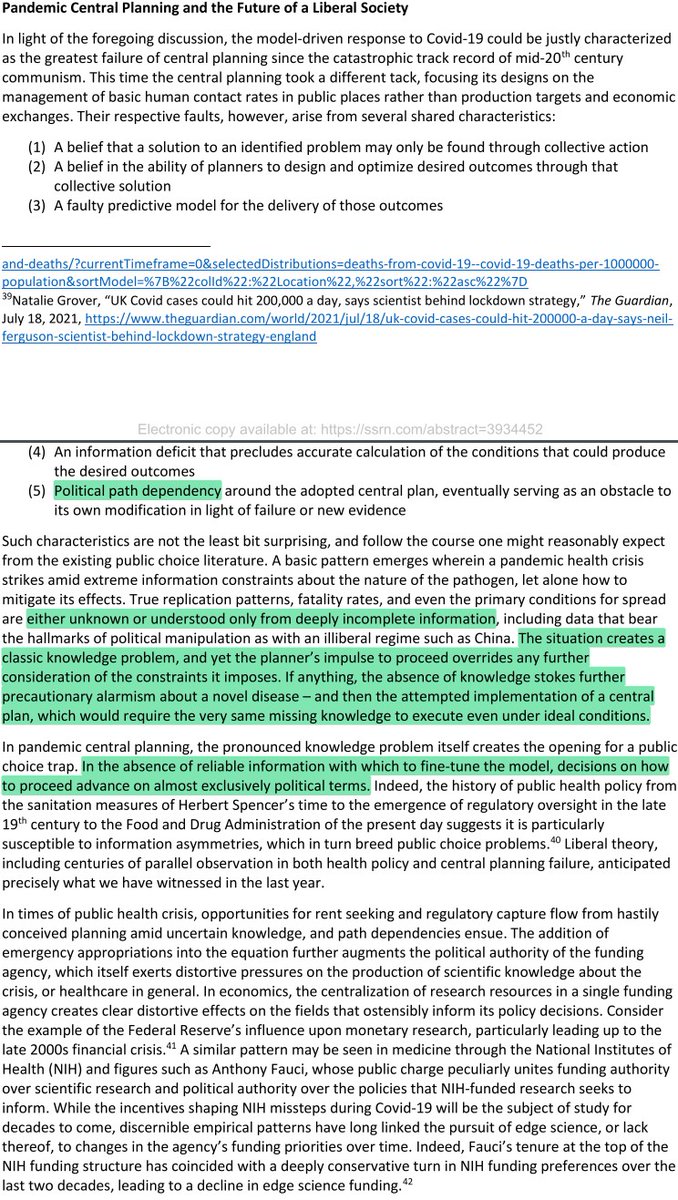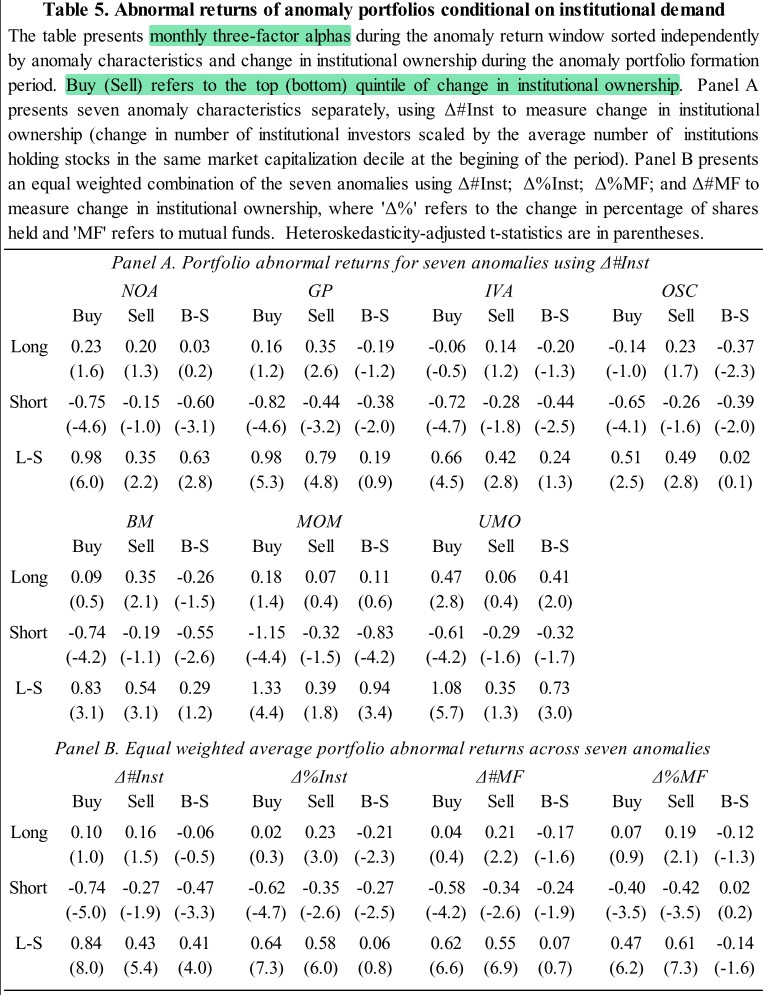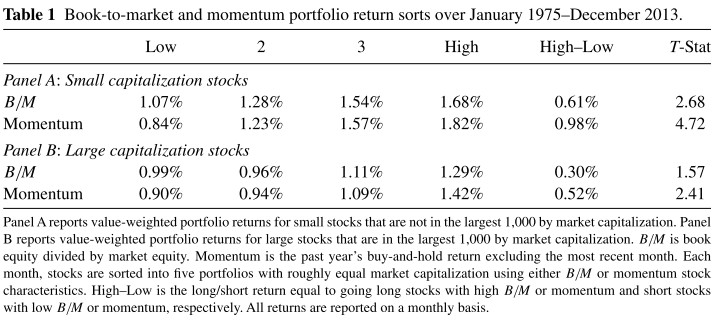
1/ Failures of Pandemic Central Planning (Magness)
"Public health is acutely susceptible to knowledge problems, which foster the conditions for a public choice trap that causes proposed policy measures to become ineffectual or even counterproductive."
papers.ssrn.com/sol3/papers.cf…
"Public health is acutely susceptible to knowledge problems, which foster the conditions for a public choice trap that causes proposed policy measures to become ineffectual or even counterproductive."
papers.ssrn.com/sol3/papers.cf…

2/ "The criticisms of Snow – that he bucked scientific consensus, that his water-borne transmission theory contradicted a self-evident effect of widely observed odors, that he threatened to undermine the Health Board’s solutions to cholera – parallels the 2020 pandemic response." 



3/ "The governments of both the U.S. and U.K. effectively endorsed the catastrophic forecasts of the ICL model along with its prescriptive approach of forestalling massive casualties by enacting a series of lockdown-style NPIs intended to control the replication of the virus." 

4/ "It predicted catastrophe in the absence of NPIs for every country.
"The ICL team didn't paused to examine whether its prescriptive NPI measures would perform in reality as their models maintained. The measures' effectiveness was implicitly presumed by the model itself.
"The ICL team didn't paused to examine whether its prescriptive NPI measures would perform in reality as their models maintained. The measures' effectiveness was implicitly presumed by the model itself.

5/ "Prior to Covid-19, a substantial body of epidemiological literature warned about the dangers of relying on theoretical modeling as a basis for respiratory pandemic mitigation.
2006: “Would closures decrease contacts between people and so retard the spread of the epidemic?
2006: “Would closures decrease contacts between people and so retard the spread of the epidemic?
6/ "Or would those affected spend more time in malls, restaurants, and other settings that might result in more contacts and more rapid spread of influenza? No model, no matter how accurate its assumptions, can predict the secondary and tertiary effects of mitigation measures.”
7/ "Interventions are highly susceptible to political distortions that shift their purposes away from public health or even to counterproductive directions.
"Ferguson’s chosen assumptions for NPI-induced contact rate changes display no evidence of their own empirical validity."
"Ferguson’s chosen assumptions for NPI-induced contact rate changes display no evidence of their own empirical validity."

8/ "By following a policy built around the prescriptive focus of the ICL model’s scenarios (which intentionally omitted care homes and prisons), government bodies almost certainly made the outbreak in nursing homes significantly worse." 

9/ "The unmitigated spread scenario, which dominated the headlines, overstated mortality by between 137% in hard-hit Mexico to 1,300,000% in Taiwan, which largely avoided a major outbreak for the first year even though it did not employ lockdowns or most NPIs during this period." 

10/ "ICL’s projections severely overestimated mortality irrespective of the policy interventions taken. Even the unrealistic “suppression” scenario (heavy-handed lockdown for over a year until full vaccination) resulted in a median overestimate of 535% vs. what really happened." 

11/ "Flaxman's study implicitly assumes the validity of Imperial’s own mortality projections. These are then treated as a “counterfactual” to compare to observed data.
"Similar claims of unwarranted causality appears in other studies testing the effectiveness of lockdowns/NPIs."
"Similar claims of unwarranted causality appears in other studies testing the effectiveness of lockdowns/NPIs."

12/ "Of the 39 papers considered, 26 claimed to show a causal relationship between lockdowns and pandemic control, yet the majority of those papers (65%) lacked an appropriate causal inference technique to support such conclusions." 

13/ "Pro-lockdown studies that lacked appropriate causal inference testing (including Flaxman) tended to be cited in epidemiology journals at a much higher rate than those with more suitable statistical techniques." 

14/ "Deeply incomplete information creates a classic knowledge problem, but the absence of knowledge stokes precautionary alarmism and the attempted implementation of a central plan, which would require the very same missing knowledge to execute even under ideal conditions." 

15/ "In pandemic central planning, the pronounced knowledge problem itself creates the opening for a public choice trap.
"In the absence of reliable information with which to fine-tune the model, decisions on how to proceed advance on almost exclusively political terms."
"In the absence of reliable information with which to fine-tune the model, decisions on how to proceed advance on almost exclusively political terms."
16/ "Though Bowman attributes the apex and decline of Britain’s death numbers to lockdowns kicking in and working, the successive waves followed a nearly identical pattern without the implementation of these policies in Sweden." 

17/ "The case surges predicted by Fauci and the modelers in Florida, Georgia, Texas, and similar open locales simply failed to materialize. When cases did rise in these states, they appear to have followed regional and seasonal patterns, unconnected to any lockdown or other NPI."
18/ More reading:
Three Myths about Federal Regulation
First Literature Review: Lockdowns Only Had a Small Effect on COVID-19 (Herby)
Covid Lockdown Cost/Benefits: A Critical Assessment of the Literature
Three Myths about Federal Regulation
https://twitter.com/ReformedTrader/status/1460043729104883712
First Literature Review: Lockdowns Only Had a Small Effect on COVID-19 (Herby)
https://twitter.com/ReformedTrader/status/1385269627337334792
Covid Lockdown Cost/Benefits: A Critical Assessment of the Literature
https://twitter.com/ReformedTrader/status/1385280566644248579
• • •
Missing some Tweet in this thread? You can try to
force a refresh



























